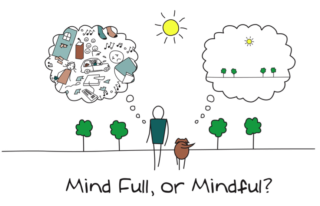As we continue to count down the days to the holidays, it can be easy to lose sight of what the true meaning of this time of year is about. Over the last few weeks, we have shared some Mindfulness Strategies for the Holidaze and some goal setting tips for Setting SMART New Year’s Resolutions to offer a helping hand for getting the most out of December. None the less, there are times when the most wonderful time of the year may not always feel so wonderful.
Though it’s been said, many times many ways (pun intended), mindfulness is great tool that can help give some perspective to allow for present moment connection. There are many different times and ways to practice mindfulness. Below are some helpful activities the whole family can try out to help stay connected to what you really value this time of year.
Mindfulness when Travelling:

For some of us, the hustle and bustle from point A-to-B is an essential part of the holidays. Unfortunately, unpredictable weather conditions, traffic, and the occasional “are we there yet?”, travelling may feel more like a chore.
Ask everyone in the car to describe what they see, hear, feel, smell, and even taste. Put on some favourite holiday music, create games out of passing cars and landscapes, or have everyone reflect on what they have enjoyed most about the holidays so far. One of my favourite games to play in the car while growing up was the License Plate Game.
Here is how you play:
Play as individuals or as a team, and try to see how many different license plates you can find on your trip. If you will be making many trips, a fun option may be to write them down and over the course of your holiday travel, see how many different license plates you find.
As simple as it may be, this simple task can be helpful to take your mind off how busy the roads are or how late you are running, and encourages you to notice your surroundings and connect with the people you are travelling with.
Mindfulness during Gift Opening:

If gift opening is a popular tradition in your home, this is a great opportunity to practice informal mindfulness. Similar to the mindfulness while travelling, this strategy is one the whole family can try.
Start by taking in your surroundings. What do you notice?
What sounds do you hear? Yes, it may be noisy, but amidst the noise what can you really hear? Crinkling of paper? Laughter? Heartfelt thank you’s? The fire place crackling?
What do you see? What colours are the wrapping paper? Are there ribbons or bows? Children having fun? The lights sparkling on the tree?
What do you smell? Your morning coffee or hot cocoa? The scent of breakfast lingering or dinner in the oven? Do you smell pine needles or wood on the fire?
What do you feel? The texture of the wrapping or tissue paper in your hand? How does it feel in your hands? Where are you sitting? On a chair or couch? Is the room warm and cozy? Are your feet in socks or slippers?
Can you taste anything? Perhaps the sips of cocoa or eggnog?
By slowing down and connecting with your senses, you may notice some simple joys that may have gone otherwise unnoticed.
Mindful Communication:

This is one mindfulness practice that is useful every day, however, is an important one for me around the holidays. Spending time with family and friends, especially those we do not get see often, is a common tradition for many. Practicing mindfulness while communicating with our loved ones can be a gift in and of itself.
To practice mindful communication, it is important to be fully connected to the conversation. Make eye contact. Listen. Wait patiently for the other person to finish before speaking. Limit distractions. If smartphones, TV, or video games are big distractions, suggest limited use during times when gathering with family and friends. Encourage family to leave their devices in another room, or provide a phone basket for everyone to keep their phones in to reduce the autopilot nature of phone checking every so often.
A little goes a long way when it comes to mindful communication, and it will be sure to feel good to fully connect and communicate with everyone.
Mindful Eating:

It is no surprise the holidays come with lots of excuses to indulge which can certainly challenge our waistline come January 1st.
Practice eating awareness. Begin to notice your hunger cues in your body. Engage your senses. Notice the smells, taste, and texture of the foods.
Practice becoming aware of the food in front of you. Are you fully aware of the food you’re choosing? Do you like everything that is on your plate? Do you notice when you have finished a certain food item? Do you enjoy every bite?
Being mindful while eating can be a challenge, so take your time, and enjoy the moments around food this holiday.
Stay tuned in the New Year for more on Mindful Eating for Weight Control!
We hope these Mindfulness tips help you take time to notice the simple joys of the holiday season.
From all of us at OHS, we wish you and yours, a happy and safe holiday.







 In fact, most of us likely practice the opposite of mindful eating, we are more likely engaging in mindless eating. We lack awareness of how we fill our plate, or our portion size. We eat in front of the TV or computer, and we do not notice cues in our body signaling us that we are full. With mindless eating, most of us can consume an unnoticed 200-300 calories each day, which overtime can lead to unwanted weight gain. Consider this: have you ever been eating chips and went to put your hand in the bag, only to find it empty? Or have you ever eaten the last piece of crusty, dried out chocolate cake even though it tasted like cardboard?
In fact, most of us likely practice the opposite of mindful eating, we are more likely engaging in mindless eating. We lack awareness of how we fill our plate, or our portion size. We eat in front of the TV or computer, and we do not notice cues in our body signaling us that we are full. With mindless eating, most of us can consume an unnoticed 200-300 calories each day, which overtime can lead to unwanted weight gain. Consider this: have you ever been eating chips and went to put your hand in the bag, only to find it empty? Or have you ever eaten the last piece of crusty, dried out chocolate cake even though it tasted like cardboard?






